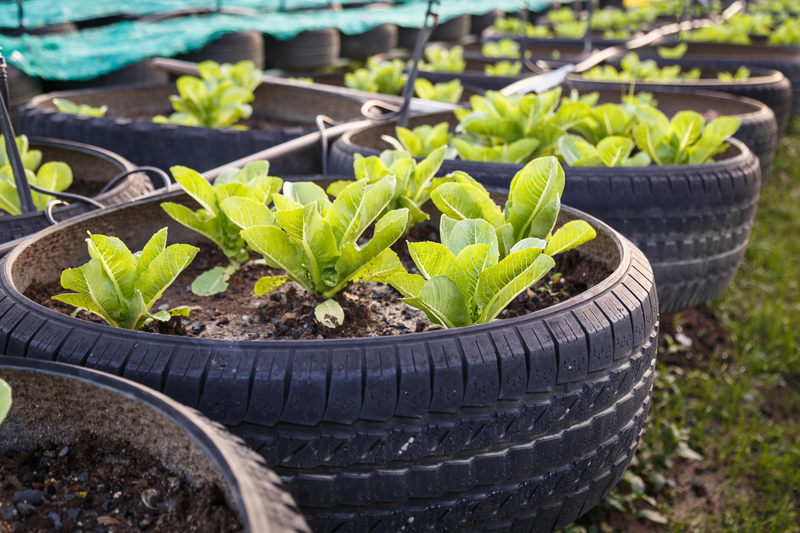How to Responsibly Get Rid of Unwanted Cookware
Getting rid of unwanted cookware can be surprisingly tricky. Whether you are upgrading your pots and pans, downsizing, or simply decluttering, you may wonder: What's the best way to dispose of old cookware? Discarding them in the dumpster isn't always the most sustainable option. In this comprehensive guide, we'll cover several methods and tips for responsibly disposing of unused cookware, while considering environmental impact, community benefit, and creativity.
Why Responsible Cookware Disposal Matters
Many types of kitchenware and cookware--such as non-stick pans, aluminum pots, stainless steel skillets, ceramic casserole dishes, and cast iron--can last for years. However, when their non-stick coating peels, handles break, or you simply replace them, they can quickly become unwanted clutter. Simply tossing them in the trash often means adding unnecessary waste to landfills. In addition, some materials in cookware may not biodegrade or may even release toxic substances as they break down.
Disposing of cookware responsibly protects the planet and may even help your community. With the right approach, you can minimize waste, conserve resources, and maybe even help someone in need. Read on to discover how to get rid of used cookware responsibly and sustainably.

Assess Your Unwanted Cookware
Before you get rid of old pots and pans, take a close look at each item and ask yourself a few questions:
- Is it still usable? Just because it no longer fits your needs doesn't mean it won't work for someone else.
- Is it broken, warped, or damaged?
- What material is it made from? (e.g., aluminum, copper, stainless steel, non-stick coating, ceramic, cast iron)
- Does it have sentimental or unique value? Heirloom cookware may deserve a second life, even if it's no longer practical for cooking.
Once you've sorted your old cookware, you can choose the best disposal method based on its condition and material.
Best Ways to Responsibly Dispose of Old Cookware
1. Donate Usable Cookware to Charity
If your cookware is still functional, donation is often the most impactful option. Many organizations gladly accept gently-used pots, pans, and kitchen gadgets. Here's how:
- Charity thrift stores: Places like Goodwill, The Salvation Army, and local thrift shops often accept cookware. Be sure items are clean and in good condition.
- Nonprofit organizations: Some shelters, community centers, halfway houses, churches, or soup kitchens may accept cookware donations to assist people in need or to support their own meal services.
- College students or first-time renters: Post in community groups, social media, or local college forums. Students moving into their first apartment frequently need cheap or free kitchen gear.
Tip: Wipe down all cookware, remove loose food, and bundle sets together for easy handling. Always call ahead to confirm that your selected organization can accept your donation.
2. Recycle Your Old Cookware
Some cookware materials, especially metals like aluminum, copper, and stainless steel, are recyclable. But, can you recycle cookware at the curb? Typically, no--most municipal recycling programs don't accept pots and pans in regular bins, because their size and material can damage sorting equipment. However, here's what you can do:
- Scrap metal yards: These facilities accept metal cookware such as stainless steel, copper, and aluminum pots and pans--even if they're non-stick (as long as you scrape off loose coatings). You may even earn a small payout by recycling valuable metals!
- Special recycling programs: Some municipal waste management centers run periodic events for recycling "hard to dispose of" items. Search for community collection days or special drop-off sites in your area.
- Take-back programs: Some cookware manufacturers or retailers offer take-back or trade-in programs. For example, certain brands may allow customers to return old pots and pans in exchange for discounts or proper recycling. Check the manufacturer's website or customer service for details.
Pro Tip: Always check materials before taking cookware to a scrap yard. Cookware with plastic or wooden handles may need disassembly. Non-stick coatings can sometimes disqualify items; call your local facility to clarify what types of cookware they accept.
3. Sell or Swap Your Gently-Used Pots and Pans
If your cookware is in good shape and a recognizable brand, you can try selling it online or through local channels.
- Online marketplaces: Platforms like Facebook Marketplace, Craigslist, and eBay are ideal for listing pots, pans, skillets, or cookware sets. Take clear photos, describe any wear and tear, and be honest about the age and condition.
- Community "Buy Nothing" or swap groups: These local social media groups encourage reusing and sharing unwanted household items for free. This promotes sustainability and builds community connections.
- Yard sales and flea markets: Sell cookware alongside other unused items. Sets tend to sell better than single pieces.
*Selling or swapping cookware not only clears space in your kitchen, but can help others get affordable or even free kitchen tools*.
4. Upcycle and Repurpose Cookware for New Uses
Even if your cookware is too battered for the kitchen, it may still have life left as something else. Here are a few creative upcycling ideas for old pots and pans:
- Garden planters: Turn old saucepans, colanders, or Dutch ovens into unique flowerpots or herb gardens. Drill a drainage hole and fill with soil for instant outdoor charm.
- Decor and organizers: Use skillets or baking pans as wall art, rustic serving trays, or quirky storage bins in the garage or craft room.
- Bird baths or feeders: Upside-down lids, shallow pans, or even bundt pans can become attractive homes or feeding stations for backyard birds.
- Candle holders or soap molds: Metal muffin tins, ramekins, or small baking pans are great for homemade candles or soap bars.
Why upcycle? Repurposing keeps cookware out of landfills and adds personality to your home or garden.
5. Dispose of Unusable Cookware Properly
If your cookware is cracked, chipped, rusted through, or otherwise not safe for cooking or upcycling, you may need to simply dispose of it. Here's how to do so responsibly:
- Double-check recycling options: Even heavily damaged metal cookware is often accepted at scrap yards.
- Ceramic and glass cookware: Most ceramic, Pyrex, or glass bakeware isn't recyclable in standard curbside bins because it's treated for high temperatures. Check for specialized drop-off locations in your city, or wrap carefully in paper or a box before disposing of in the trash.
- Non-stick cookware: Old Teflon or other non-stick pans should not go in recycling. If the coating is badly peeling or flaking, do not donate or reuse for food purposes. Wrap securely before discarding to avoid hazards.
- Cast iron: Even the rustiest old skillet can often be restored. If not, scrap yards usually accept them.
*Never put large pots, pans, or bakeware in municipal recycling without checking with your local waste authority first, as they may disrupt sorting machines or pose hazards to workers*.
Special Considerations: Non-Stick and Teflon Pans
Non-stick pans, especially those with Teflon (PTFE) coatings, require extra caution. When the coating is scratched, flaking, or worn off, old non-stick pans can release toxins at high heat. Here's what to keep in mind:
- Reuse with caution: If just slightly worn, repurpose non-stick pans for use as organizers, planters, or craft holders--not for cooking.
- Do not recycle non-stick at curbside: The coating is not compatible with most municipal recycling systems.
- Manufacturer take-backs: Some companies, like Calphalon, have periodic programs for returning non-stick cookware for safe disposal or recycling.
- If trashing: Wrap securely to prevent hazardous dust and scratches, and label if instructed by your waste management provider.
How to Make Cookware Last Longer
Preventing excess waste starts at home. Here are a few tips to extend the life of your cookware (and reduce future disposal needs):
- Use non-metal utensils with non-stick and ceramic pans to avoid scratches.
- Hand-wash pans when possible, or follow manufacturer care guidelines.
- Avoid sudden temperature changes that can warp or crack pots.
- Periodically re-season cast iron or carbon steel to maintain a non-stick surface.
- Store lids and handles carefully to prevent breakage.
Treating your cookware well not only saves you money but reduces waste and environmental impact in the long run.
Cookware Disposal FAQ
Can I put old pots and pans in the recycling bin?
No, most household recycling programs do not accept cookware, due to their size, mixed materials, and potential coatings. Always contact your local recycling center or scrap yard to find specialized drop-off options.
Where can I donate unwanted cookware?
You can donate functional cookware to:
- Thrift shops (Goodwill, Salvation Army)
- Homeless or women's shelters
- Churches or soup kitchens
- Neighbors through community groups or websites
Are non-stick pans hazardous when old?
Old, scratched non-stick pans may release harmful chemicals, especially when overheated. Do not donate or use deteriorating non-stick cookware for cooking. Repurpose them for non-food uses or dispose of them following your area's waste guidelines.
What about glass and ceramic cookware?
Standard curbside recycling does not accept glass cookware (like Pyrex) or ceramics, as these materials have a different melting point from bottles and jars. Check for local drop-off centers or wrap securely and dispose of as instructed by your waste provider.

The Environmental Impact of Discarded Cookware
Approximately 12 million tons of durable goods like cookware end up in landfills annually in the United States alone. Metal pots and pans, once landfilled, do not break down and can remain for centuries. Non-stick coatings may also leach chemicals over time. By responsibly disposing of unwanted kitchenware, you actively contribute to reducing waste, conserving resources, and protecting the planet.
Conclusion: Make Your Cookware Count Even After Use
With a little planning, it's easy to get rid of unwanted cookware responsibly. Whether you choose to donate, recycle, upcycle, or properly trash your old pots and pans, you're making a conscious choice that benefits both the environment and your community.
- Donate usable items to those in need.
- Recycle metals and check for special options for glass or ceramic.
- Get creative with upcycling for fun and functional projects.
- Safely dispose of items that can't be used or recycled.
The next time you clean your kitchen, remember that where your old cookware goes matters. With smart, responsible actions, we can all help reduce waste and create a better tomorrow--one saucepan at a time.